Remember Brevity: Jeff Tries to Jam in A Best Of/Shopping Lists.
/![]() I like "best of" lists, particularly before the holidays when people have a bit of cash and trying to figure out what to get loved ones. So I'm gonna do one even though (a) I've been more than a little out of the loop since I left the store in May; (b) my brain is still like well-chewed taffy after writing this week's reviews; and (c) my tech karma just took a massive hit, with my external hard drive unresponsive, my alphasmart wiped, and my image search for book covers (because everyone loves images) hit a snag when a page tried to install a fuckin' trojan horse on my laptop. (Oh, and what's up with our sidebar?) So I'll try to make this as quick and coherent--and as non-crabby--as possible for all our sakes. Sorry about the lack of graphics. Maybe next year, provided my laptop isn't too busy sending out Jamaican porn spam.
In sloppy alpha order:
I like "best of" lists, particularly before the holidays when people have a bit of cash and trying to figure out what to get loved ones. So I'm gonna do one even though (a) I've been more than a little out of the loop since I left the store in May; (b) my brain is still like well-chewed taffy after writing this week's reviews; and (c) my tech karma just took a massive hit, with my external hard drive unresponsive, my alphasmart wiped, and my image search for book covers (because everyone loves images) hit a snag when a page tried to install a fuckin' trojan horse on my laptop. (Oh, and what's up with our sidebar?) So I'll try to make this as quick and coherent--and as non-crabby--as possible for all our sakes. Sorry about the lack of graphics. Maybe next year, provided my laptop isn't too busy sending out Jamaican porn spam.
In sloppy alpha order:
AMERICAN ELF VOL. 2: These two years of James Kochalka's cartoon diaries may be so brightly colored they'll make your eyes water, but they're also funny, sweet and profane. I hope we continue to get book collections of these even though Kochalka's cartoon vault is now open online.
AZUMANGA DAIOH OMNIBUS: I read and loved all four volumes of Kiyohiko Azuma's comic strip tales of a batch of high school girls, and hope this collection of the four volumes finds all the new readers the series well deserves. ADV Manga didn't really put themselves out throwing this omnibus together--the translation notes from vols. 3 and 4 don't reflect the new pagination, for example--but the price break and convenience of having them all in one spot still make it a great buy. Plus, it's an excuse to re-read everything all over again, which I did, and I enjoyed them just as much the second time around.
LEAGUE OF EXTRAORDINARY GENTLEMEN BLACK DOSSIER: Black Dossier probably suffers by dint of authorial over-ambition, publisher politics, and audience expectation, but it's still a helluva book. Even though it failed to move me emotionally, I frequently took delight in the clever formalistic shenanigans, and Kevin O'Neill does landmark work. Plus, you know, a Tijuana Bible version of Orwell's 1984--how can you knock that?
BUFFY SEASON EIGHT VOL. 1 TPB: Joss Whedon brings the Buffyverse back for a TV season on paper, and it's a delight for those of us who still carry tremendous affection for the characters. While I worry the "unlimited budget" of comics may keep Whedon away from the limitations on TV he ably turned into strengths, or that the work will get farmed out the more other projects occupy Whedon's time, the first storyline was a tremendous amount of fun on its own, and a great gift for a Buffy fan (if you can find one that doesn't already have this, of course).
CRECY: I think this may be in the top five things Ellis has ever done, if not the top three--a dark, smart, rowdy educational history lesson where the author's predilection for technical knowledge and street-smart narrators meshes perfectly in showing us the battle of Crecy and its impact on how cultures make war. It's as perfectly executed as it is conceived, tremendously engaging and deeply enjoyable. Great stuff.
CRIMINAL: COWARD and CRIMINAL: LAWLESS: Ed Brubaker and Sean Phillips produce two exceptionally strong stories that nail the grit, seedy glamor and understated desp all great crime stories have. Phillips' extraordinary knack for visual characterization enhances Brubaker's ability to bring exactly the right amount of information to a scene; I can't think of a current writer-artist team who play to each other's strengths nearly as well as these two.
DR. 13: ARCHITECTURE & MORTALITY TPB: Brian Azzarello and Cliff Chiang's playful metafiction tackles current comic book policies, the nature of belief and disbelief, and is a gorgeous-looking repudiation of what superhero books can and cannot do. It'll make you think, but it'll also make you laugh--a lot.
DRIFTING CLASSROOM: Kazuo Umezu's manga classic about an elementary school transported to a hostile dimension is bracing in its bleakness, touching in its melodrama, and masterful in its cartooning. It is also, in the very best sense, ape-shit crazy. Imagine if Lost starred the Little Rascals and somebody was dying or suffering gruesomely every fifteen minutes, and you get a slight idea of Drifting Classroom's ghastly, loopy charms.
EXIT WOUNDS: Rutu Modan's extraordinary graphic novel about a young man in Israel trying to discover the fate of his father is still the book of the year for me. The cartooning is great--detailed and evocative and open--but the writing is extraordinary, deepening the characters and the situations on every page. I really loved this book.
FLOWER OF LIFE, VOLS. 1-3: Fumi Yoshinaga's witty story of high school students and manga fans is always moving in directions you won't expect, but, really, it's the mix of light comedy and deep characterization I find so compelling. Like Yotsuba&! or Azumanga Daioh, this stuff makes me happy when I read it--it's heartwarming, which is something I'd never thought I'd enjoy in my reading material, but when it's done as well it is here, I'm helpless to resist.
FOURTH WORLD OMNIBUS, VOLS 1-3: Near-masterpieces of presentation, these collections of Jack Kirby's classic Fourth World material choose to reprint the work in order of publication. And while that has its drawbacks, particularly in the Volume Two where an extended storyline in The Forever People loses momentum as issues are spaced eighty pages apart, it pays off in Volume Three where Kirby begins to pull the threads of his stories together, and brilliant sequence after brilliant sequence begin to follow each after the next. Stunning.
KAMANDI ARCHIVES VOL. 2: In fact, reading the second volume of the Fourth World Omnibus, Marvel's Devil Dinosaur collection and this second volume reprinting Kirby's Kamandi stories in a row rendered all other comics completely uninteresting for about two weeks there. Whereas part of the delight of the Fourth World books is seeing how someone as distinctive and as regimented as Kirby was during that period still brings subtly different rhythms to each book, Kamandi entertains because it is constantly moving, keeping the title character (and the readers) from one crazy situation to the next. As far as I know, it's the closest Kirby ever got to the breakneck pacing of the great newspaper strips, and it makes for an intoxicating read. I really hope DC gets around to collecting all of these.
KING CITY VOL. 1 TPB: Speaking of intoxicating reads, King City by Brandon Scott Graham is, like Kirby's work, fast-paced and jammed with ideas, and unmistakably the work of a single idiosyncratic creator. It's deeply, deeply goofy, more than a little cocksure, and lord only knows when we'll see Volume 2, but this book reminded me of the first Scott Pilgrim book in its ability to take disparate influences and effortlessly marry 'em. I was so impressed with this book, I bought three copies to give to friends and lend out.
MISERY LOVES COMEDY HC: Somehow, by compiling the first three issues of Schizo--letter pages and all--under one cover and including an introduction from his therapist, Brunetti made me look at his comics in a new light. I already thought they were brilliant--Brunetti embodies every cliche of the unhappy indie cartoonist and transcends them through talent and fearlessness--but here they seem even more impressive, a radically brave act of self-expression. Plus, it's all funnier than hell.
MONSTER: Naoki Urasawa's sprawling suspense story is a deeply satisfying page-turner. Kinda reminds me of Dickens in its sheer narrative drive, and Urasawa's cartooning also has a love of expressive caricature. These can't come out fast enough for me.
PARASYTE VOLS. 1 AND 2: The first two volumes of Hitoshi Iwaaki's Parasyte remind me of both DC's Focus line and Marvel's Ultimate Spider-Man as a teen gains great power via the alien creature that's replaced his right arm. It might be a good book for superhero fans looking to branch out; it's certainly a great book for those of us who already have.
THE PROFESSOR'S DAUGHTER: Joann Sfar and Emmanuel Guibert's turn of the century farce about an animated mummy king on the lam with the professor's daughter is everything you'd want in a graphic novel--funny, action-packed, beautiful and surprisingly moving.
SCOTT PILGRIM GETS IT TOGETHER: The fourth volume in the series, and arguably the strongest since the first. Creator Bryan Lee O'Malley gets it together even more than Scott, taking his storytelling and his cartooning to a new level, and giving us a perfectly paced and satisfying book.
ANYTHING BY TEZUKA PUBLISHED BY VERTICAL: In the space of a week and a half, I read Apollo's Song, Ode to Kirihito and MW, and was dumbstruck by Osamu Tezuka's utter genius. MW is a crazed crime novel in which a homosexual crossdressing crime lord matches wits with the priest who is his lover with the fate of the human race at stake; Apollo's Song is a psychedelic coming of age novel in which a potential psychopath is taught the power of love thanks to cross space/time scenarios, and Ode to Kirihito (published late last year) is a surreal world-spanning medical thriller that reads a little bit like if Jodorowsky had directed a Dr. Kildare movie after Dostoyevsky did a pass on the script. They're all brilliant and insane, buoyed up by Tezuka's wide-ranging mastery of the cartoon medium and open-armed embrace of melodramatic directness. I enjoyed Ode to Kirihito the most, but I loved all of them. I guess I'm finally ready to tackle Buddha.
YOTSUBA&! VOLS. 4 AND 5: Like Azumanga Daioh and Flower of Life, a light comedy I find both heartwarming, well-observed, and mostly perfectly timed. I never thought I'd champion a cute kid comic book, but Yotsuba&! has exactly the right amount of cute, avoiding the all-too-standard saccharine crud that usually comes with it.
STUFF NOT ON THE LIST BECAUSE I (STILL) HAVEN'T READ IT: Alice in Sunderland, Pulphope, other stuff I'm sure you'll point out.
STUFF I REALLY ENJOYED THAT DIDN'T MAKE THE LIST BECAUSE I WAS EITHER TOO LAZY OR THERE WERE MITIGATING CIRCUMSTANCES: Jason Shiga's Bookhunter (brilliant but a bit pricey for me); Rick Veitch's Army At Love Vol. 1 (enjoyable but uneven); Empowered Vol. 1 (I thought Vol. 2 was disappointing enough to taint Vol. 1 for me); Iron Man: Hypervelocity TPB (great fun in the singles; haven't checked to see if it holds up in the trades); The Escapists HC (ditto); Devil Dinosaur Omnibus (too pricey); JoJo's Bizarre Adventure (not for everyone; haven't I mentioned enough manga?); Brubaker's Captain America and Daredevil TPBs (I'm behind); Sgt. Frog (not enough volumes this year); Beck Mongolian Chop Squad (wait between volumes hurts the pacing; otherwise brilliant); Fart Party; probably many others I'm forgetting.
Anything that came out this year (in trade format) I missed?
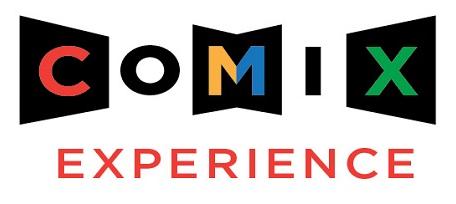

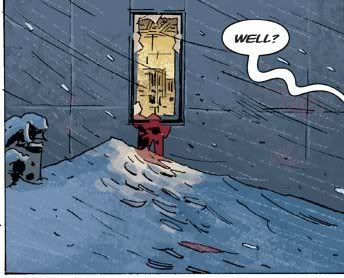
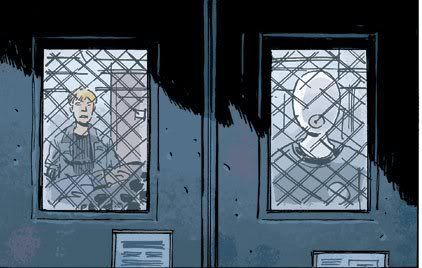
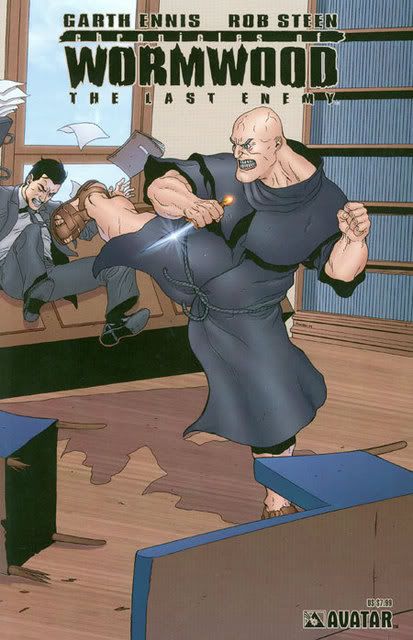
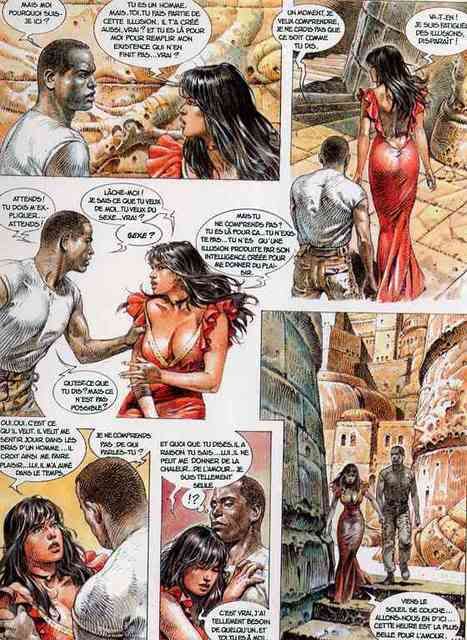

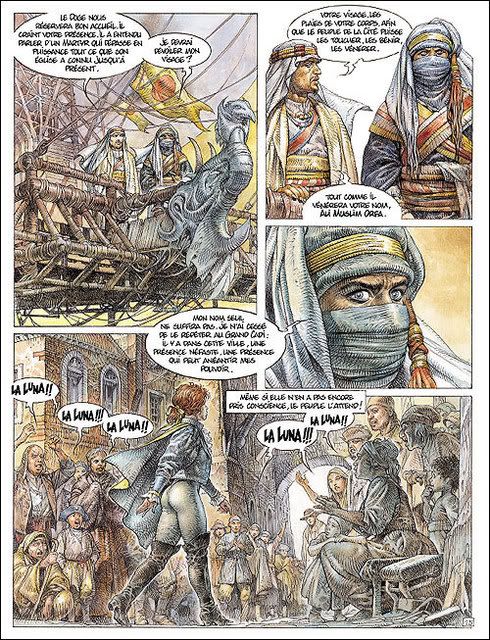 (pardon the non-English illustration)
(pardon the non-English illustration)









